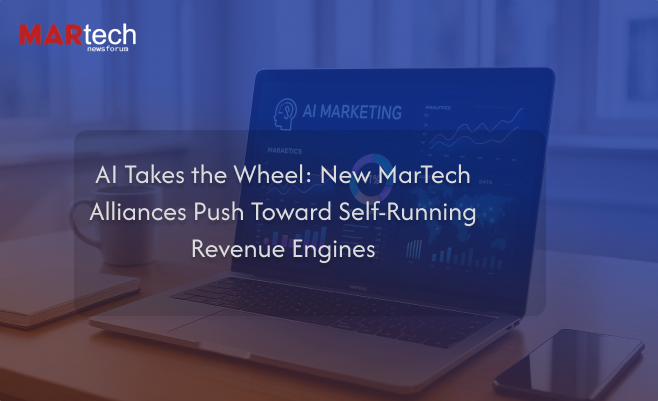
A new wave of strategic alliances and AI-driven innovations is redefining the marketing technology (MarTech) landscape, pushing it toward a future where platforms evolve into autonomous, self-optimizing revenue engines. This transformation is not just about incremental automation—it marks the shift from human-directed execution to AI-orchestrated marketing ecosystems capable of running complex revenue operations with minimal human intervention.
From Automation to Autonomy
Historically, marketing technology has centered on workflow automation—email campaigns, lead scoring, content scheduling. But in 2025, the leading MarTech players are moving toward agentic AI—AI systems that can make decisions, execute tasks, and self-improve without constant oversight.
Unlike traditional automation, which follows rigid pre-programmed rules, agentic AI combines natural language understanding, predictive analytics, and adaptive learning. This allows it to perform functions such as:
- Selecting optimal campaign strategies based on real-time data.
- Adjusting budgets and channel allocations dynamically.
- Generating and testing creative assets automatically.
- Personalizing customer experiences at an individual level.
Adobe’s Strategic AI Push
At the Adobe Summit 2025, the company unveiled Agent Orchestrator and Brand Concierge, embedded within the Adobe Experience Platform.
- Agent Orchestrator coordinates multiple specialized AI agents across different marketing functions—creative, analytics, personalization—ensuring all actions are aligned to overarching business goals.
- Brand Concierge acts as a governance layer, enforcing brand guidelines while AI agents produce and deploy content at scale.
Adobe also deepened alliances with Accenture, Deloitte Digital, EY, and IBM to help enterprises implement agentic AI within existing MarTech stacks, enabling cross-platform coordination between Adobe and non-Adobe systems.
AI-Native Platforms Enter the Field
Other players are quickly carving space in this emerging category:
- Apexon’s AgentRise offers enterprise-grade AI agents that manage entire campaign lifecycles—from segmentation to reporting—without manual intervention.
- LTIMindtree + Adobe launched BlueVerse CraftStudio, combining composable MarTech architecture with AI-driven creative optimization.
- MarkeTeam.ai, fresh from a $3M seed funding round, is building a pure AI-native agent ecosystem for marketing creativity, dynamic personalization, and campaign orchestration.
The “Self-Running Revenue Engine” Model
The concept gaining traction is the Self-Running Revenue Engine—a marketing ecosystem where AI agents handle every stage of the revenue cycle:
- Market Sensing – Monitoring trends, competitors, and audience behavior in real time.
- Strategy Generation – Creating multi-channel marketing plans based on predictive models.
- Execution – Producing content, targeting ads, and triggering outreach sequences automatically.
- Optimization – Continuously testing, learning, and reallocating resources for maximum ROI.
- Attribution & Reporting – Delivering revenue impact reports without analyst intervention.
This shift moves marketers from “button-clickers” to “strategic overseers,” focusing on vision and brand direction while AI handles operational execution.
Market Data Signals the Shift
According to Accenture’s 2025 AI in Business Report, enterprises that have integrated AI agents into core marketing workflows report:
- 7.3% faster revenue growth year-over-year.
- 11% reduction in operational costs within 18 months.
- 13% productivity increase across marketing teams.
Additionally, Scott Brinker, VP of Platform Ecosystem at HubSpot, points to a 27% increase in AI-driven automation adoption as the MarTech industry surpasses 14,000 active tools worldwide in 2025. The complexity of these stacks is driving demand for centralized, intelligent orchestration.
Cross-Industry Implications
The move toward AI-run revenue engines has implications beyond marketing:
- Sales – AI agents are scoring leads in real time, routing high-intent prospects directly to reps.
- Customer Success – Predictive churn models trigger retention campaigns before customers disengage.
- Finance – Revenue forecasts are being updated dynamically as campaigns adjust mid-flight.
These interconnected systems create a closed feedback loop, where every customer interaction feeds data back into the AI, making the next cycle smarter.
Challenges Ahead
While the promise is compelling, adopting autonomous MarTech systems poses challenges:
- Governance & Compliance – AI must adhere to brand rules, privacy laws, and ethical boundaries.
- Data Integration – Disparate systems must feed into a unified AI layer without data loss.
- Skill Shift – Teams will need expertise in AI strategy, prompt engineering, and cross-platform orchestration.
Enterprises are increasingly turning to consulting partners to navigate these complexities, accelerating the trend toward bundled technology-services alliances.
The Road Ahead
By 2030, analysts predict 50% of enterprise marketing activities could be handled by autonomous systems. The winners will not be those with the largest tech stacks, but those with tightly integrated, AI-driven ecosystems aligned to revenue outcomes.
As alliances deepen and AI agents grow more capable, the marketing function is evolving into a command center for self-running revenue machines—where human creativity sets the vision, and AI executes with relentless efficiency.